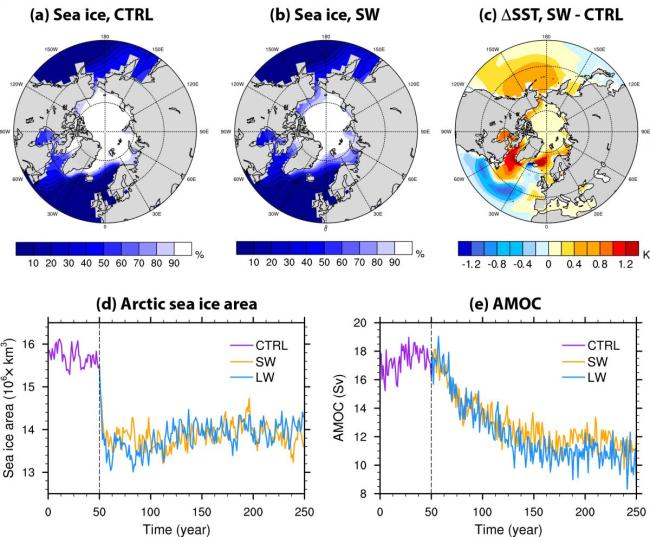Understanding the effect of Arctic sea ice decline on the Atlantic meridional overturning circulation
Can the ongoing Arctic sea ice decline weaken the Atlantic meridional overturning circulation (AMOC)? This is a question raised by a new study recently published in Nature Climate Change. The conventional view on the connection between the AMOC and Arctic sea ice is that a weakening of the AMOC should reduce ocean poleward heat transport and, hence, expand sea ice. However, can sea ice changes affect the AMOC? The authors argue that this is exactly what happens on multi-decadal timescales. The idea is that Arctic sea ice decline would expose the ocean to anomalous surface heat and freshwater fluxes, resulting in positive buoyancy anomalies that can propagate downstream to the North Atlantic, in due time suppressing deep convection and weakening the AMOC.

The study consists of several interrelated parts. In the first one, the authors use an optimal flux perturbations framework and an adjoint approach to estimate the AMOC sensitivity to ocean surface buoyancy forcing over the Arctic and globally. This analysis shows that on decadal timescales surface flux anomalies over the subpolar North Atlantic have the largest impact on the AMOC; however, on multi-decadal timescales (longer than 20-30 years), it is flux anomalies in the Arctic that become more important. Then the authors use the observed, or more accurately described “reconstructed,” flux anomalies over the Arctic for the past three decades to force a forward ocean model. The experiment shows an AMOC gradual decline on the order of 2-4 Sv, comparable to the recent AMOC weakening captured by the RAPID array over the last decade. Finally, the authors conduct sensitivity experiments using a comprehensive coupled climate model wherein they impose a sea ice reduction comparable to the observed since the 1980s. The AMOC in these computations loses up to 40% of its strength (Figure). At the same time, a cooling anomaly develops over a localized region of the North Atlantic reminiscent of the so-called “Warming Hole” observed at subpolar latitudes. Therefore, the Arctic sea ice decline may explain the suggested slow-down of the AMOC and the persistence of the Warming Hole. The main conclusion of the study is that by modulating meridional overturning circulation Arctic sea ice can play an active role in ocean and climate change.
Arctic sea-ice decline weakens the Atlantic Meridional Overturning Circulation (Nature Climate Change)
Topics
- Sea Ice
- Modeling
- Atlantic Ocean
- Climate Change
- Arctic
- AMOC
